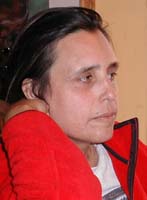By Dan Gunderson
Minnesota Public Radio
December 21, 2001
Nearly 40 percent of American Indians in Minnesota will get diabetes. They are also more likely to suffer serious side effects. On the White Earth Reservation, a pilot project is trying to reduce the effects of diabetes by bringing back a diet based on traditional native foods.
| |
|
|
|
||
Eighty-three-year-old Margaret Smith doesn't have time to sit and talk. She has a van full of food to deliver to homes scattered across the northern Minnesota reservation.
Smith found her diabetes was much easier to control when she ate a traditional diet that included wild rice and hominy corn. She set out to convince others to change their diets.
"I just had to go and find these people myself," said Smith. "I'd go to one place and they'd say, so and so is diabetic too. So that's how I found everybody. I found 175 people."
Smith is the catalyst and engine for this project. She drives hundreds of miles delivering 175 sacks of food every month to elders with diabetes. The deliveries take about two weeks. She makes the 175 jars of jam that are part of each month's food package.
| |
|
|
|
||
She also has to face treacherous roads and occasionally inhospitable dogs.
At one stop an elderly man chases the dogs away and helps Smith pack another sack of buffalo meat, wild rice, hominy corn, jam, maple syrup and fresh roasted coffee.
"It's a real good program." said Harry. "We eat a lot of hominy, we eat a lot of wild rice. We drink a lot of coffee too. It's really good, too. We love that maple syrup, too."
Harry said his wife is diabetic. He thinks traditional native foods help keep her healthy.
As she drives across the northern Minnesota reservation, Smith talks about the toll diabetes takes on Indian people. She can think of ten people who have succumbed to the disease in recent months. Dozens suffer from serious complications. Margaret Smith remembers growing up in a time when diabetes was not a serious health issue.
"We had a good diet. Rice and deer meat, ducks, fish. That's what we had to live on," said Smith.
But poverty and government food programs have transformed the diet of many American Indians. They eat primarily cheap processed foods. Obesity is at epidemic levels.
Margaret Smith has been delivering food packages for only two months, but already people call and ask to be added to the list. It's estimated there are some 600 diabetics on the reservation.
Margaret has to turn people away every week. There's no funding to expand the program.
| |
|
|
|
||
"I'm starting this program on a prayer and a shoestring," said Winona Laduke.
Laduke is founder of the White Earth Land Recovery project. She administers the mino miijiim, or good food,program.
"We started with 20 thousand dollars of leftover money we had for food and we got some money from the Lutheran church and the Presbyterians," explained Laduke. "I'm incredibly thankful for that start, but I need $100,000 to run this program."
The land recovery project harvested the wild rice, hominy corn, maple syrup and berries used in the food distribution.
In a recent milestone of sorts, a buffalo was butchered to provide meat.
"I cried and cried when we killed that buffalo," said Laduke. "My son was there and I sang a song for the buffalo and we prayed. But that buffalo went to feed our old people."
Laduke also hopes to introduce traditional foods into the school lunch programs on the reservation. She thinks there's a chance to prevent diabetes in the next generation.
Laduke said research proves a traditional diet reduces the incidence of diabetes and the complications caused by the disease. Diabetes experts agree diet and exercise are critical to controlling diabetes.
Laduke believes state and federal government agencies could see significant health care cost reductions on the reservation if there's even a partial return to traditional foods. She is also convinced Indian people will benefit physically and spiritually from eating the foods the creator intended for them.
More Information



